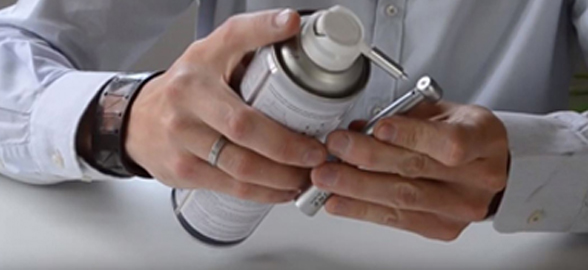After our previous article: "Everything you should know about endodontic files: (I) Manual files" here comes the continuation to this.
With the passage of time, endodontics has modernized with the rise of more powerful technologies and in order to meet the needs of dentists across the world. Consequently, rotary and mechanized endodontic files were created to help prepare the root canal in a more comfortable and practical way. This does not mean that we have turned our backs on manual files, but rather use these new technologie as a supplement to manual files in order to facilitate endodontic treatments.
In addition to this, modern endodontics not only involves rotary files as mechanized instruments, but also a wide variety of devices to facilitate endodontic treatment, such as endodontic motors or apex locators, among others.
Make sure you take into consideration the details and main features associated with each one of these files and technologies.
ROTARY ENDODONTIC FILES
Rotary files can be continuously, or reciprocally, rotating.
1. Ligthspeed. Files with a non-cutting tip available in most sizes.
2. Wave One (Dentsply Maillefer). These files shape the root canals by means of a reciprocating asymmetric movements, which means that they continuously change their direction of rotation during the forming procedure with a large turning angle in the cutting direction and a smaller angle in the reverse direction (allowing it to progress along the canal path, with respect to the root's anatomy). They are divided into three varieties:
- The WaveOneTM PRIMARY file (025.08) is designed to fully prepare most root canals.
- The WaveOneTM SMALL file (021.06) is used to either replace the K 010 file, or for use on the lower incisors, the MBII ducts of the upper molars and/or the ducts with apical curvatures.
- The WaveOneTM LARGE (040.08) file will be used instead of the K 020 file if it reaches the expected length, or for use on the upper incisors, the single duct premolars and some molars with larger diameter ducts.
Subsequent to the Wave One files, the Wave One Gold system was designed in 2015, with 70% more flexibility than the primary system and providing greater channel preparation safety. The files are available in three classic lengths: 21, 25 and 31 mm with a short 11 mm handle for improved access to the back teeth. Additionally, it shortens duct preparation time by 23% and further reduces clinical fatigue.
Differences between the two systems:
- The Wave One system is made in M-wire and the new Wave One Gold has a heat treatment after its manufacture, obtaining a new alloy, called GOLD.
- The Wave One system has a pure convex triangular section from D9 to D16 and modified from D1 to D8, while the Wave One Gold system has a parallelogram section with 85º edges.
Click here to see the Wave One files
3. Protaper (Dentsply Maillefer, Tulsa, Okla.). Convex triangular cross-section with rounded edges and slightly negative cutting angle. At the entry of the active part, at D1, the taper is 0.02 mm/mm, but every 2 millimetres, until D16 is reached, the taper increases by 0.02 mm/2mm. They are divided into two groups:
- SHAPING FILES. 14mm active part remodeling instrument for chopping movement. In turn they are furthermore divided into:
- SX (golden ring, to widen the coronal third of the duct). Being the shortest of all files (19 mm), it has a diameter in D1 of 0.19 mm.
- S1 (lilac ring, to widen the coronal and middle third of the duct). With an apical diameter D1 of 0,17.
- S2 (white ring, to widen the middle third of the duct). With a diameter of D1 of 0.20 mm.
- FINISHING FILES. Finishing instrument for increasing the diameter of the root canal to make the apical stop within the root canal. According to the manufacturer, these files should only be used once, but studies show that they can be used more often. Available in 21, 25 and 31 mm and with 16 mm active part and constant taper on the 3 mm apicals. They are divided into several groups:
- F1. Yellow ring, ISO 20, taper 7% and a diameter in D1 of 0.20 mm
- F2. Red ring, ISO 25, taper 8% and a diameter in D1 of 0.25 mm
- F3. Blue ring, ISO 30, taper 9% and a diameter in D1 of 0.30 mm.
- F4. Black ring, ISO 40, taper 6% and a diameter in D1 of 0.40mm.
- F5. Yellow ring, ISO 50, taper 5 and a diameter in D1 of 0.50 mm.
- Click here to see the Protaper files
Click here to see the Protaper files
4. Protaper Next. UNIQUE in rotary endodontic files. Why so? Have a look!
5. Easy Race (Reamer with Alternating Cutting Edges). Stretcher with alternating cutting edges.
- Inactive tip, which ensures good guidance and good centering
- Triangular cross-section. Allows for better penetration and cutting.
- Square cross-section for small files (15-.02 and 20-.02).
- With "Safety Memo Disc (SMD)" system that makes it easy to count the number of uses of each instrument. It has 8 petals that are discarded as it is implemented. Once all the petals have been removed, discard the file.
- They are divided into two groups: PreRaCe and RaCe.
6. GT / Profile (Great Tapers) (Dentsply Maillefer). For the Crown-Down technique..
-
With a taper of 6%, 8%, 10% and 12% and with a length of 21 and 25 millimetres.
Click here to see the Pofile files.
7. Maillefer Profile.
8. Quantec Series 2000. They are manufactured in tapers: 0'02, 0'03, 0'04, 0'05 and 0'06mm. And in various free: #15, #20, #25, #30, #35, #40, #45, #50, #55 and #60.
- Cross-section with asymmetrical design and slightly positive helocoidal angle of cut.
- They are available in two types of tips: the SC, faceted and shear, and the LX, rounded and inactive for wide ducts.
9. Profile Series 29. These files and reamers are used in a different calibration systems, with a constant increase of 29% between tip diameters. This offers a progressive and smooth expansion of the canal.
- Inactive tip.
- For manual use or machining.
- From caliber 20 to 110, including intermediates such as 22.5, 27.5, etc. to number 60.
10. Hero 642 (High Elasticity in Rotation) (Micro Mega). Files with inactive transition angle. With a three-point helix, it is used to channel the helical dentin remains towards the crown.
- The 6% taper files are manufactured in the lengths 21 and 25 mm, while the 4% and 2% taper files are available in the lengths 21, 25 and 29 mm.
11. K3 Endo (Sybron Dental Specialties). They are the evolution of the Quantec files as they have been designed by McSpadden and Kerr engineers.
- Variable helocoidal angle.
- Triple striated.
- More efficient than files with neutral or negative cutting angle.
- Passive safety tip. Helps avoid steps.
- Conicalities from .02 to.12. in lengths 21, 25 and 30 mm.
- Available sizes: #15, #20, #25, #30, #35, #40, #45, #50, #55 and #60.
Click here to see the K3 files
12. Hyflex. Files ideal for narrow ducts. HyFlex files are manufactured using a unique process in which the crystallographic phase moves from austenite to martensite at room temperature. They are divided into four systems:
- Hyflex EDM. Depending on the clinical situation, the use of HyFlex EDM files is reduced to 2-3 files, especially in straight and larger channels. All HyFlex EDM NiTi files can be used at 400rpm and with a torque of up to 2.5Ncm (25 mNm), with the exception of Glidepath files, which can be used at 300rpm and with a torque of up to 1.8 Ncm (18 mNm).
- Hyflex EDM / CM. For medium curvature channels, a combination of HyFlex EDM and HyFlex CM files (500 rpm; 2.5 Ncm (25 mNm)) is recommended.
- Hyflex CM. The single-length technique, in which all files are used, except the Orifice Opener, cut to length up to the working length, allows precise and anatomically accurate preparation with HyFlex CM files. Again, all files except the Orifice Opener can be used up to the working length (500 rpm; 2.5 Ncm (25 mNm)).
- Hyflex GPF (Glidepath). HyFlex GPFs are designed for duct navigation and routing, ensuring optimal access path shaping thanks to their controlled memory. They are characterized by excellent durability and tear resistance.
Click here to see the Hyflex files
13. Twisted File. The TF technique includes only 3 files per box, perfectly adapted to the type of tooth you are treating: 1 set for anterior teeth, another for premolars and molars. Triangular stem.

Click here to see the Twisted files
14. Pathfile. Files specially designed for root canal catheterization.
- Active NiTi tip.
- Before using Pathfile instruments, set a path to the apex with manual files to at least 10 (ISO).
- Available in sizes: 013, 016 and 019.
Click here to see the Pathfile files
Each manufacturer has its own system of files with unique properties, so there are countless amounts of them, but these are the most-widely used presently.
DID YOU LIKE THIS ARTICLE? DON'T HESITATE TO SHARE IT! ;)




